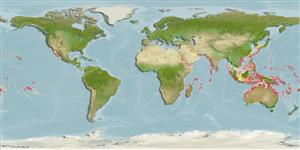>
Gobiiformes (Gobies) >
Gobiidae (Gobies) > Gobiinae
Etymology: Eviota: No etymology given, suggested by Christopher Scharpt: from Latin 'eu' for 'true' and 'iota' for anything very small, in combination 'truly very small' referring to it as being the smallest vertebrate at the time it has benn described by Jenkins (thus, making the suggestion by Scharpt plausible..
More on authors: Lachner & Karnella.
Environment: milieu / climate zone / depth range / distribution range
ນິເວດວິທະຍາ
ສັດທະເລ; ນ້ຳກ່ອຍ ກ່ຽວກັນຫີນ. Tropical
Indian Ocean.
ຂະໜາດ / ນ້ຳໜັກ / Age
Maturity: Lm ? range ? - ? cm
Max length : 1.9 cm SL ຕົວຜູ້/ບໍ່ມີເພດ; (Ref. 116739)
Inhabits dead algal-covered reef in 3-15 m (Ref. 90102). Reported to feed primarily on harpacticoid copepods (49.5% - 100% of the gut contents) and they consume an average of 249 copepods per square meter of reef surface (Ref. 116739).
Life cycle and mating behavior
Maturities | ການສືບພັນ | Spawnings | Egg(s) | Fecundities | ຕົວອ່ອນ
Tornabene, L., D.W. Greenfield and M.V. Erdmann, 2021. A review of the Eviota zebrina complex, with descriptions of four new species (Teleostei, Gobiidae). ZooKeys 1057:149-184. (Ref. 126577)
IUCN Red List Status (Ref. 130435)
Threat to humans
Harmless
Human uses
ເຄື່ອງມື
Special reports
Download XML
ແຫຼ່ງອີນເຕີເນັດ
Estimates based on models
Preferred temperature (Ref.
123201): 24.4 - 29.3, mean 28.3 °C (based on 2876 cells).
Phylogenetic diversity index (Ref.
82804): PD
50 = 0.5000 [Uniqueness, from 0.5 = low to 2.0 = high].
Bayesian length-weight: a=0.00708 (0.00333 - 0.01504), b=3.09 (2.92 - 3.26), in cm total length, based on LWR estimates for this (Sub)family-body shape (Ref.
93245).
ຊັ້ນເຂດຮ້ອນ (Ref.
69278): 3.0 ±0.3 se; based on size and trophs of closest relatives
ຄວາມຢືດຢຸ່ນ (Ref.
120179): ສູງ, ປະຊາກອນຕຳ່ສຸດທີ່ໃຊ້ເວລາສອງໜ້ອຍກວ່າ 15 ເດືອນ (Preliminary K or Fecundity.).
Fishing Vulnerability (Ref.
59153): Low vulnerability (10 of 100).
Nutrients (Ref.
124155): Calcium = 404 [167, 1,168] mg/100g; Iron = 1.54 [0.66, 3.46] mg/100g; Protein = 17.6 [15.5, 19.4] %; Omega3 = 0.106 [0.036, 0.297] g/100g; Selenium = 33.2 [9.7, 98.3] μg/100g; VitaminA = 123 [24, 593] μg/100g; Zinc = 4.31 [2.36, 7.23] mg/100g (wet weight);
